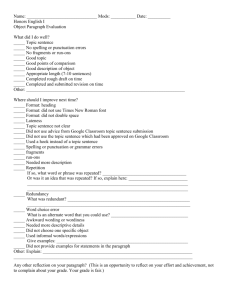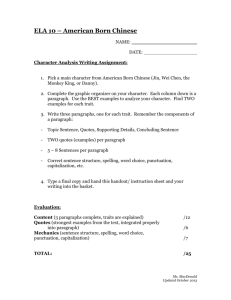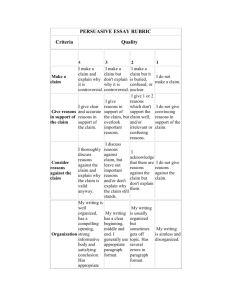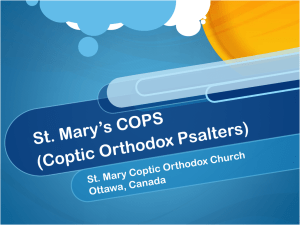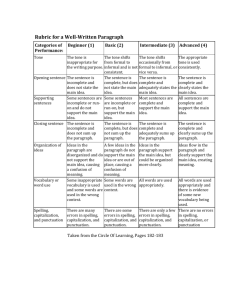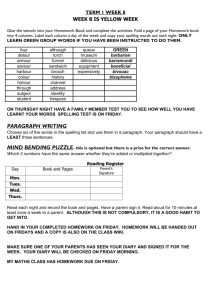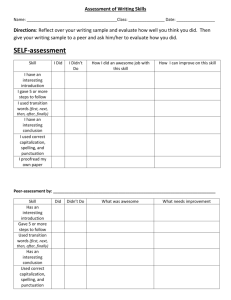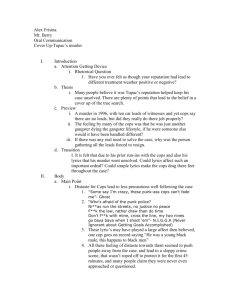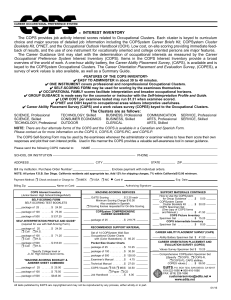Lesson Plans
advertisement
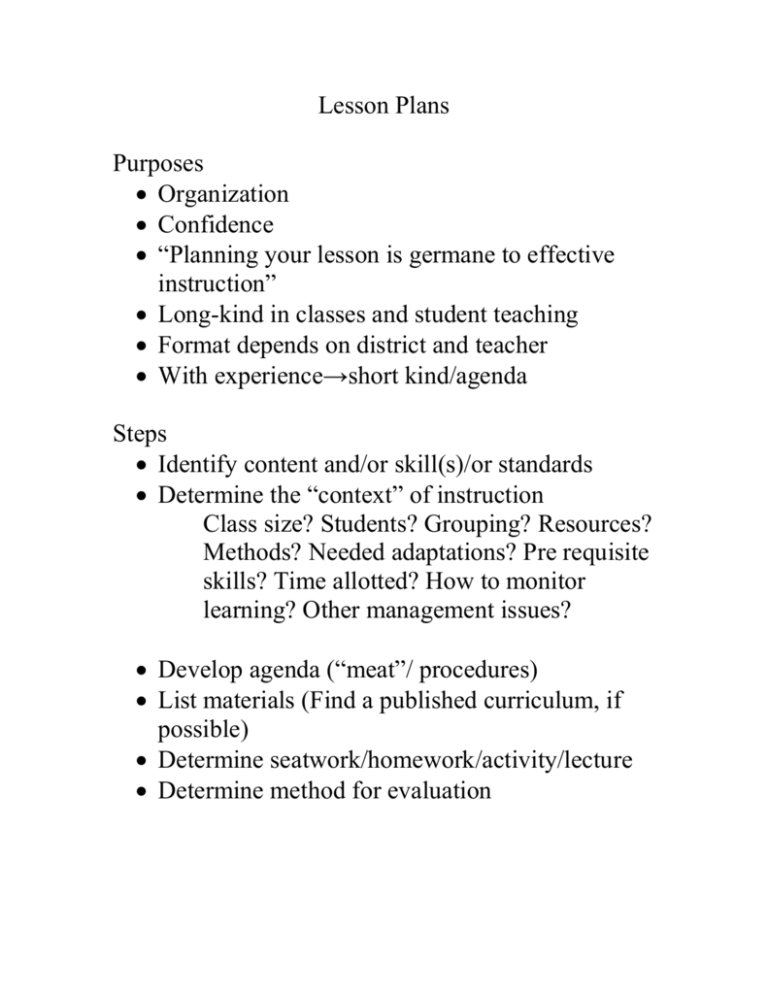
Lesson Plans Purposes Organization Confidence “Planning your lesson is germane to effective instruction” Long-kind in classes and student teaching Format depends on district and teacher With experience→short kind/agenda Steps Identify content and/or skill(s)/or standards Determine the “context” of instruction Class size? Students? Grouping? Resources? Methods? Needed adaptations? Pre requisite skills? Time allotted? How to monitor learning? Other management issues? Develop agenda (“meat”/ procedures) List materials (Find a published curriculum, if possible) Determine seatwork/homework/activity/lecture Determine method for evaluation Typical Steps 1. Introduce lesson Connect skill to previous lesson or skill Attention grabber Explicitly state the lesson objective Provide rationale for skill/lesson 2. Describe and model the skill or strategy Use the “think aloud” procedure Model each step exactly and thoroughly Be consistent with language 3. Guided practice Could be group work Use scaffolding, as needed Offer tips or reminders Gradually reduce assistance 4. Allow independent practice Do on your own Homework 5. Provide feedback throughout lesson 6. Closure Opportunity for students/teachers to recap lesson The COPS Strategy Illinois Learning Standard: 3.B.Ac Evaluate written work for its effectiveness and make recommendations for its improvement Introduction/Set: Attention Grabber: We’ve been learning about the importance of using the correct punctuation in our work. Listen as I read 2 letters written to John from his ex-girlfriend. Both letters contain the exact same words. Notice how the punctuation changes the meaning of each letter. (Read both letters and show them on overhead). Think about how the punctuation made a difference in these 2 letters. Review: Not applicable Rationale: Well, today we are going to learn a strategy to help you edit your work, so you can convey exactly the meaning you have in mind---just like John’s ex-girlfriend did. She knew exactly what she wanted to say, and she used punctuation to do it. Share lesson objectives and rationale: Today we will learn a proof reading strategy called COPS. Learning the COPS strategy will help you edit your papers better, so others can better understand your message. This strategy can also improve your grades on your written products. Student Expectations: (behavioral) I expect you to keep your eyes on me, raise your hand to answer a question or make a comment, and do your best work. (academic) By the end of the lesson, you will be able to proof read your work using the COPS strategy with very few errors. Objectives: 1. When asked by the teacher, “What do the letters C, O, P, and S stand for in the COPS strategy?” the student will correctly say, “Capitalization, overall appearance, punctuation, and spelling” with 100% accuracy on 3 out of 3 consecutive trials. 2. Given written work (i.e., a paragraph) at the student’s reading level that contains 10 errors in capitalization, overall appearance, punctuation, and spelling, the student apply the COPS strategy to proof read and find 9 out of 10 errors on 3 out of 3 consecutive trials. Materials: Overhead transparencies of introductory examples, COPS examples, and passages to proof read Overhead markers---4 different colors Handouts for students (in groups) for guided practice with colored pencils per group Homework assignment 1 per student Introduce and model strategy with overheads. Say something like: First, I’ll model how to use the COPS strategy, and then we’ll do some practicing with the strategy today. We’ll also have a homework assignment using this new strategy. I’ll be using a different color overhead pen for each step. Let me first provide an overview of the strategy for you, and then I’ll model each step for you. C stands for Capitalization- We will edit our work to make sure we have capitalized the first word of every sentence and all proper nouns O stands for Overall Appearance –We will check for any handwriting, spacing, indentation and margin errors and messy errors P stands for Punctuation-We will check our work for the appropriate end mark, commas, and semi colons S stands for Spelling-We will check to see if our words are spelled correctly. If we are not sure, we will ask ourselves: Does it look right? Can I sound it out? or Do I need to use a dictionary? Script for the model step will be: The first step in the COPS strategy is C for Capitalization. In this step, I ask myself: Did I capitalize the first word in every sentence and every proper noun? Watch as I use the C step on my paper. To do the C step, I will read every sentence and make my corrections right on my rough draft.(Orally read the paragraph which is on the overhead and circle in a particular color all the capitalization errors). The second step in COPS is O for Overall Appearance. I ask myself: Is my handwriting easy to read, on the line, and not crowded? Are my words and sentences spaced right? Did I indent and write close to the margin? Are there any messy errors? (Read the paragraph orally again as it is shown on the overhead. In a different color, make corrections right on the rough draft.) Next, I use the P step. P stands for Punctuation. I ask myself: Did I use the right punctuation mark at the end of each sentence? Did I use commas and semicolons where necessary? Watch as I use the P step on my paper. (Orally read the paragraph once more and make any corrections right on the rough draft.) Last, I use the S step. S stands for spelling. I look at any word I am unsure of and I ask: Does it look right? Can I sound it out? Should I use the dictionary? I make those spelling corrections right on my rough draft.(Orally read the paragraph once more, stopping at any spelling errors. Ask the questions above and correct the spelling errors in a different color). Guided practice- The teacher will provide a short paragraph at the students’ reading level that contains errors in each of the categories noted. The teacher will place the paragraph on the overhead, and with the class, locate errors in C, O, P, and S. (This will be similar to Daily Oral Language exercise). Students will volunteer to find an error. The teacher will guide the students with questions such as: What is our first step? (C)…yes, what does it stand for? What do we look for in the (C) step? Who can find some capitalization errors in this paragraph? Let’s read it and find the errors. (Do this with all steps until all errors have been found). Independent Practice- For homework, students will be given a letter to the editor to proof read using the COPS strategy. Closure-Well, class, you found all of the errors in that paragraph using the COPS strategy. You also were attentive, and you raised your hands to speak. Before you go to lunch, think of a situation where you could use the COPS strategy. Let’s make a quick list of those situations, and then you’ll be dismissed.
